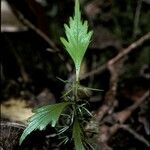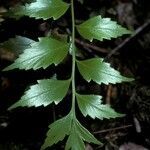Large short-boled trees to shrubs near the tree line, up to at least 30 m tall. Bark dark brown to reddish, hard with large lenticels, light brown and granular within, breaking off in large, more or less rectangular scales. Foliar buds well developed, longer and less compact on younger plants, becoming more globular on older plants. Juvenile leaves 5-8 mm long and adult scale leaves 2-3 mm long. Cladodes on young plants deeply lobed and with distinct marginal hooks representing the reduced leaves, gradually becoming more compact, diamond-shaped to more or less oval with more or less wavy margins, 3-8 by 2-3 cm, the larger sizes mostly on young sterile specimens, marginal lobes c. 5 mm wide, often glaucous especially on the lower side, aggregated alternately on lateral branches of limited growth. Pollen cones usually produced on different plants than seed cones, each in the axil of a scale at the base of a growing shoot, in clusters up to 15, sometimes mixed with reduced cladodes, cylindrical, 12-15 mm long and 3 mm diameter with a naked peduncle 5-25 mm long. Apex of the microsporophyll triangular, irregularly toothed. Seed cones in an apical notch of a bilobed cladode or terminal on a reduced cladode or on a naked stalk c. 1 cm long, occasionally more than one together, ovoid and, like new cladodes, more or less purple. bearing up to 15 scales, of which usually 1-3 are fertile, becoming bright red when mature and then drying to a leathery brown. Seed shiny brown, 5-7 mm long.
More
A large tree. It grows 25-35 m tall. The trunk is 60-100 cm across. It can have small buttresses. The bark is dark brown and rough. The shoots are flattened and leaf like. These are arranged in spirals along the stem. They are 60-80 cm long by 25-30 cm wide. Male and female flowers occur on the same plant. The cones are small. They are 5-8 mm long and 5 mm wide.



